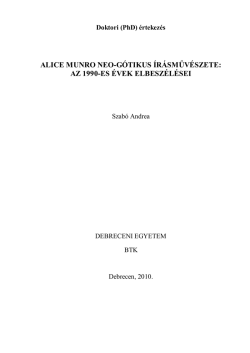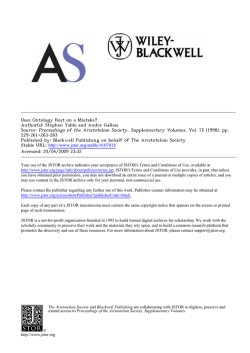
Criteria of Periodization in the History of European Art
Criteriaof Periodizationin the
Historyof European Art
I.
MeyerSchapiro
1. Apart from mathematical divisions (centuries,millenniums)
and the prehistorictool and site names with their numbered stages,
period names have been of three kinds: political-dynastic,cultural,
and aesthetic.Examples of the firstare Carolingian,Ottonian,Tudor;
of the second,Mediaeval, Gothic,Renaissance; of the third,Romanesque, Classic, Mannerist, Baroque. Each type of name originally
implied a theoryabout the art it designated.The aestheticnames are
more common,but the otherssurvive,oftenwith changed sense. We
no longer accept the original meanings of "Romanesque" and
"Gothic," but we continue to use these period names as conventions
with new historicalboundaries.
2. If periodizing is conventional,it is not entirelyarbitraryor
it is an instrumentin orderingthe
useless. As historicalclassification,
historical objects as a continuous systemin time and space, with
groupingsand divisionswhich bring out more clearly the significant
and which permit us to see a line of
similiaritiesand differences,
it
also
development;
permitscorrelationwith other historicalobjects
and events similarlyordered in time and space, and therebycontributes to explanation.
3. The same objects can be classed in many differentways, all
logical and consistentwith our knowledge of the structureof the
period classificationsare possible. It is
objects. Hence many different
the problem and the theoreticalviewpointthat determinethe choice
of a classification,with its order of generalityand its particularhistorical boundaries.
4. Since developmentis gradual and uneven, periodizingmust be
vague in its boundaries. The typesof art which seem distinctin the
particularworkscited in definingthe typesbecome less distinctwhen
we tryto specifythe earliestand latest examples of the types.And in
114
NEW LITERARY
HISTORY
some periods thereare opposed styleswith formsthat resistclassification as elementsof a commonart.
5. Independent of conflictingperiod conceptsand common to all
of them as a basic datum and axis of referenceis the irreversible
order of single workslocated in time and space. WhetherPoussin is
called Baroque or Classic, his work belongs to a definitetime and
and
place, and this position entails restrictionson all interpretations
of
art.*
his
explanations
COLUMBIA
UNIVERSITY
*
Summary of a paper read at the Annual Meeting of the American Historical
Association, 1954.
Criteriaof Periodizationin the
Historyof European Art
II.
H. W. Janson
In a famous essay,"Norm and Form," Ernst Gombrich has recently
pointed out that the "processionof stylesand periods known to every
beginner [in the historyof art] . . . representsonly a seriesof masks
for two categories,the classical and the non-classical."The former
category,in Gombrich'slisting,is representedby Classic, Renaissance,
and Neo-Classical, the latter by Romanesque, Gothic, Mannerist,
Baroque, Rococo, Romantic, all of which were originally termsof
abuse (and, we may add, Impressionistand Cubist). Present-dayart
historiansno longershare the positiveor negativevalues once implicit
in theselabels. "We believe we can now use themin a purelyneutral,
purely descriptivesense." But, the author points out, this confidence
is justifiedonly so long as we do not tryto definethe limitsof these
categoriestoo closely.When we do, we soon realize the fundamental
differencebetween our methods of classificationand those of the
zoologist: "In the discussionof worksof art descriptioncan never be
completelydivorced from criticism."Hence our perplexitiesin the
debate about stylesand periods.
Gombrich is certainlyright.The very fact that we still use these
traditionalterms,howevermuch theirmeaning has shiftedsince they
firstgained currency,betokens a kind of intellectual imprisonment.
Afterall, even if we succeed in eliminatingeverytraceof theirnormative flavor,theyfreezethe currentgroupingsand divisionswithinthe
historyof art and thus discourageus fromlooking for possible alternatives. We are all in Gombrich's debt, then, for having made us
aware of the extent to which we are playingwith loaded dice. Nor
can we, I think,hope to play the game withoutloaded dice of some
sort (although we mightwell want to exchange some or all of our
Gombrich'sfaithin "objective
presentset forothers),notwithstanding
criteria"for judging such mattersas correctnessof drawing,balanced
116
NEW LITERARY HISTORY
composition,lucid narrative,and the presentationof physicalbeauty
as classical norms.Be that as it may,the insighthis essayprovidesinto
the hidden normativeweightingof so many of our key termschallenges us to reexaminethe entire"processionof stylesand periods" in
Westernart. (Prehistoricand non-Westernart have problemsof their
own, some of which are dealt with in George Kubler's essay,but they
are of anothersort.)
The historian of literature- or, for that matter,of any subject
other than the visual arts - is likely to wonder, as he looks over
Gombrich'slist of terms,why thereare so many more of them than
he is accustomedto in his own field.He will also want to know what
exactly is the differencebetween "styles" and "periods." The two
questions are not unrelated,althoughthe link betweenthemmay not
be obvious at firstglance. They become even more pressingonce we
realize that Gombrich's "procession" is far from complete (for his
purposes,it did not have to be) : it omitsArchaic ("non-yet-Classic"),
Hellenistic ("no-longer-Classic"),and Mediaeval, threetermsconspicuously normativein origin,as well as the non-weightedtermsderived
from political-dynasticor cultural entities such as Roman, Early
Christian,Byzantine,Carolingian,Ottonian. This lattergroup refers
to successivephases of Westernart during the firstthousandyearsof
our era. There are no weightedlabels within this veryconsiderable
time span, for the simple reason that it was thoughtunworthyof
serious attentionuntil the presentcentury.Nor are theresuch labels
for any of the phases of ancient art precedingthe Archaic. Measured
in purely chronologicalterms,then,Gombrich'snormativecategories
cover only two limited areas: Greek art fromabout 6oo B.C. to the
Roman conquest, and Western European art from about iooo to
1900. Both are centeredon "peaks of perfection"- Classic Greek art
of the centurybetween Pericles and Alexander the Great, and the
Italian High Renaissance around 1500. Gombrich concerns himself
only with these 1500 years,out of a total of more than 5000 during
which we can trace a continuous traditionfor historicWestern art,
beginningwith the Old Kingdom in Egypt. He does so because they
embrace the traditionalcore areas of art historicalstudy,and because
to him the twin peaks of Classic Greek and Italian High Renaissance
art remain objective realities. Whether or not we share the latter
conviction (there are many today who resistit) we can well understand why he concentrateson the "weighted"phases of Westernart;
for the weightingitself,regardlessof its validity,has been unquestioninglyaccepted forso long that it now is a historicfactof the first
importance.We do not know who firstproclaimed the doctrinethat
Greekart had reached perfectionin what we are accustomedto calling
HISTORY
OF EUROPEAN
ART
117
the Classic age, but it must have been widelyaccepted not later than
the time of Augustus.As Gombrich has demonstrated,it was taken
for grantedby both Pliny and Vitruvius,the two Roman authors on
whom Vasari modeled his account of the developmentof Renaissance
art toward perfectionin Michelangelo and Raphael. This normative
view also affectsour knowledgeof the monumentsthemselves:works
of art cherishedas Classic stand a far betterchance than othersto be
known to posterity.Even if the originalsare destroyed,theytend to
survive in multiple copies, like the Doryphorus of Polyclitus.The
same attitude is reflectedin two artisticphenomena that have been
with us since Roman (and perhaps since Hellenistic) times- Classicism, the conscious imitationof the Classic, and Archaism,the imitation, for special purposes, of the not-yet-Classicor indeed of the
downrightBarbaric (Primitivism).Finally, the belief in Classic perfection has colored our view of the evolution of artistic traditions
quite unrelated (or assumed to be unrelated) to the Greek heritage.
Thus Gothic art is oftenregardedas having reached its peak in the
High Gothic or Classic Gothic cathedralsof France between 1200 and
1250, aftera fairlybrief Early Gothic phase and before a verylong
late Gothic phase that lasted into the sixteenthcentury.Some modern
scholarsspeak of Classic Mayan art or Classic Indian sculpture; and
certain kinds of African Negro sculpture have been acclaimed as
Classic examples of Primitiveart. We even findperfectionin negative
achievement (e.g., a Classic faux-pas,a Classic boner), although here
Classic has lost its evolutionaryimplications.
The idea that Greek art - or any other art that formsa coherent
tradition- strivestoward the perfectrealization of its potential and
then declines, is obviously patternedon the life cycle of the individual: a fairlyrapid growthto maturityfollowedby a gradual but ever
more perceptible lessening of creative power. The analogy may be
thoughtnaive, just because it is so close at hand. A more sophisticated
model drawn from the realm of biology would seem desirable but
remains to be found. Still, imputing a quasi-human life to artistic
formshas one signal virtue: it postulatesthat theirevolution is irreversible. This is more than can be said of the alternativemethod,
descended from the aestheticsof Burke and Schiller,which regards
the historyof art as a seriesof pendulum swingsbetweenpolar opposites such as Optic and Haptic, Additive and Divisive. Gombrich
rightlypoints out the shortcomingsof such schemata and pleads for
an unabashed "perfectionism."The life-cycleanalogy, however, is
peculiarlyselective.We tend to apply it only to what we thinkof as
periods of exceptionallyhigh achievement;the rest of the historyof
art (which is to say most of it) has no clearly perceived peaks of
118
NEW LITERARY
HISTORY
perfection.There is no Classic phase in the art of Ancient Egypt or
Mesopotamia, nor in Roman art or the art of the earlier Middle
Ages. At the same time,we exempt individualsof exceptionallyhigh
artisticrank fromthe standard life-cyclepattern- who would dare
to claim that the late worksof Rembrandtor Beethovenrepresenta
decline fromtheirpeak achievements?
Gombrich does not help us to resolve these paradoxes. When he
warns that normativelyweightedtermssuch as those he lists are not
readily convertibleinto value-neutralmorphological ones, he does
not want us to cease using these labels altogether;he argues,rather,
against the belief that "all worksof art createdin these distinctperiods of human history.., .must sharesome profoundquality or essence
which characterizesall manifestationsof the Gothic or the Baroque."
Among art historians,this belief is clearly on the wane today. But
on what grounds, we wonder, does Gombrich speak of Gothic or
Baroque as "distinctperiods of human history"if there is no such
thing as Gothic Man or Baroque Man? Even if we assume that he
meant "distinctperiodsof art history"(whichneed not correspondto
periods in other fieldsof history)his answer is less than satisfactory.
He advocates what he calls "a principle of exclusion" instead of a
searchforcommonmorphologicalfeatures,such as the desireto avoid
being academic which he claims is shared by all present-dayartists.
While it is truethat Gothic and Baroque originatedas termsof exclusion (i.e., designatingtwo different
ways of being other-than-classic),
I find it difficultto discern an equivalent "desire to avoid" which
could be said to unite all Gothic or Baroque artists.How meaningful,
for instance, would it be to state that Rubens and Vermeer both
wanted to avoid being like Raphael? As a matterof fact,Rubens but not Vermeer- did want to be like Raphael in some ways.Meyer
Schapiro has pointed out that "in some periods there are opposed
styleswithformsthatresistclassificationas elementsof a commonart."
This has been increasinglytrue ever since the fifteenth
century,and is
evidenttoday.But the morediversethe styleswithina given
strikingly
time span, the less helpfulbecomesGombrich'sprincipleof exclusion.
To say that all modern artistswant to avoid being academic tells us
nothing about their various ways of not being academic, and it is
these,afterall, that interestus. Art historiansspecializingin the nineteenthand twentiethcenturiesanalyze their subject not in termsof
periods, styles,or schools but of movements (e.g., Impressionism,
Cubism, Dada, Pop), none of them dominant or stable enough to be
"period styles" at any time but identifiablenonetheless by their
morphological and ideological continuity.It is not unhistorical,I
think, to regard the Gothic as a movement- perhaps the earliest
HISTORY
OF EUROPEAN
ART
119
clearlydiscernibleone in the historyof art; startingat the Abbey of
St.-Denis shortlybefore 1150, it spread at varyingrates of speed in
every direction until, a centurylater, it had transformedthe art of
the entireCatholic West. From thenon, the manyregionalvariantsof
Gothic collectivelyformedthe period styleof the West forabout two
hundred years,a period style identifiablenot by a common essence
but by the morphologicalcontinuityof each regionalvariantwith the
original Gothic of the Ile de France. Moreover,the restof Europe was
quite aware of the origin of Gothic; it was known abroad as opus
francigenumor opus modernum- the firststyleto be labeled "modern" by its own practitioners.Thus we hardly need a principle of
exclusion (even if we are willing to assume that Abbot Suger of
St.-Denisand his masons were motivatedby such a negative aim) in
order to defineGothic as a distinctperiod of art history.
Surprisinglyenough, some awareness of opus francigenumas the
earliest modern architectureseems to have survived the coining of
the derogatorylabel of Gothic. The Cyclopaedia of Ephraim Chambers, firstissued in 1727, informsus s.v. "Gothic architecture"that
there are two kinds, ancient and modern; the former,broughtfrom
the North by the Goths in the fifthcentury,is exceedinglymassive,
heavy and coarse, while modern Gothic runs to the other extreme,
being light,delicate, and rich to a fault. Under "Architecture,"we
furtherread thatmodernGothic was encouragedby the Frenchkings,
especiallyHughes and Robert Capet. Finally,s.v. "Modern," we learn
that the term "modern architecture"is sometimesapplied, though
improperly,to both the "Italian mannerof building,as being according to the rules of the antique," and Gothic architecture;it ought to
be used for architecture"which partakes partlyof the antique ...
and partly of the Gothic." Here apparently Chambers excerpted a
differentsource. One wonders what examples of "partly antique,
partly Gothic" buildings that author had in mind; certain sevenFrench chaiteauxand English countryhouses might
teenth-century
definition.
his
As for "ancient Gothic," it obviouslyrefersto
satisfy
what a centurylater was dubbed Romanesque (corruptRoman) to
distinguishit more clearlyfromCapetian Gothic,which by then was
veryhighlyregarded.
As an art historicallabel, Romanesque has had a career very differentfromthat of Gothic. Coined as a term of exclusion denoting
medieval architecturebeforethe Gothic,it covereda varietyof styles
over a span of some 700 years.The earlier of these styleshave since
been given separate,value-neutralterms (Anglo-Saxon,Carolingian,
Ottonian), so that Romanesque todayrefersto the architectureassociated with the revival of large-scalesculpture from the late tenth to
120
NEW LITERARY
HISTORY
the twelthcentury;it also refersto the sculptureand paintingof this
two-hundred-year
span. But its lower boundaries remain vague, and
its morphologicalfeaturesvaryso much fromplace to place that the
concept of a Romanesque "period style"is far less coherentthan that
of Gothic. As a consequence, therehave been no claims that Romanesque art expresses the spiritual essence of Romanesque Man as
distinctfrom Gothic Man; in fact,Wilhelm Worringer,writingon
the Geist der Gotik shortlybeforethe FirstWorld War (the English
translationhas the misleading title,Form in Gothic) discoveredthe
"Gothic spirit" in all sorts of Romanesque and pre-Romanesque
works.
If Gothic - and its conceptualdescendant,Romanesque - are likely
to remainmeaningfulas both stylesand periods,thiscannot be said of
two other members of Gombrich's "procession," Mannerism and
Baroque. Mannerism (derived frommaniera, a pejorative label for
the imitatorsof Michelangelo and Raphael in the writingsof classicisticItalian criticsof the seventeenthcentury)was launched by Max
Dvorik in 1920 as a major period in literatureand the visual arts
interveningbetween High Renaissance and Baroque but akin to
neither.Dvorik saw it as related both to the Middle Ages and the
twentiethcenturyin its returnto spiritual absolutes and its aversion
to sensuous nature. Aftermore than fortyyears of controversy
John
Shearman, the most recentcritic to attempta definitionof Mannerism as a major period in the historyof art (as well as of literatureand
music), regardsit as a directoutgrowthof the High Renaissance and
termsit "the stylishstyle."This would seem to be an attemptto split
the difference
betweenthe Dvorak factionand the reductionistcritics
(Gombrich,Craig Smyth)to whom Mannerismis only one of several
stylesduring the interval between High Renaissance and Baroque.
The latterview is likelyto prevail. The statusof Baroque as a major
period in the historyof art embracingthe seventeenthand part of
the eighteenthcenturyvaries fromcountryto country.It is least fully
accepted in England and France (wherethe originalpejorativemeaning of the word as a synonymfor bizarreor extravagantstill appears
in currentdictionaries); more so in Americaand Italy (under German
influence); and withoutreservationin Germanyas early as 1888, in
had argued for the BaRenaissance und Barock, Heinrich Wb1fflin
distinct
values
of
its own ratherthan as a
a
with
as
period style
roque
At
version
of
Renaissance
late
art).
present,art historians
degenerate
have threealternativewaysof employingBaroque: as an art historical
period of the same order of magnitude as Renaissance; as an art
historicalperiod within the Renaissance, i.e. the last major subdivision of the Renaissance conceived as a "megaperiod" (to use a term
HISTORY
OF EUROPEAN
ART
121
proposed by Erwin Panofsky) separatingthe Middle Ages fromthe
Modern era (in this frameof reference,its order of magnitude corresponds to that of Gothic); and as one of several trends of style
between 16oo and 1750, exemplifiedby Rubens, Pietro da Cortona,
and Bernini. The firstalternativetends to postulateBaroque Man as
distinctfromRenaissance Man and Gothic Man (in a famouslecture
from
of 1913, W61fflinclaimed that the Baroque "saw differently"
the Renaissance) whose spiritualessence is presumablyexpressednot
only in art but in literatureand music as well; to demonstratethis
essence requires great ingenuityin manipulatingabstractconceptsas
well as a veryjudicious choice of examples.The second,more modest
alternative offersfewer difficulties:it accommodates a certain continuityof developmentfromthe sixteenthto the seventeenthcentury
and is less in conflictwiththe periodizationpatternsof otherbranches
of history;even here, however,there is an implicit assumption of
morphologicalunity that cannot be readily demonstrated.Only the
third alternativeleaves us free to admit how difficultit is to bring,
let us say, Georges de La Tour, Poussin, and Pietro da Cortona (all
paintersborn withinthreeyearsof each other) into a commonfocus;
but it poses the problem of how to classifyand label all those artistic
phenomena that lie outside this restricteddefinitionof Baroque.
Ideally, such labels ought to conveysomethingof the aestheticqualities of the worksof art to which theyrefer.Yet, to judge frompast
experience,labels of thiskind are apt to be coined only in the heat of
criticalacclaim or disapproval,and are thus automatically"weighted."
Value-neutral,purelymorphologicallabels, it seems,can be coined and made to stick- only in the realm of ornament (e.g., strapwork).
The art historianlooking for termsto apply to what he perceivesas
non-Baroque stylesin the seventeenthcenturyis thus likelyto borrow
them frompolitical history (Queen Anne, Restoration,Louis XIV)
and to endow them with as much morphologicalsignificanceas they
can accommodate. If their capacity is often all too limited, these
political-dynasticlabels at least have the virtue of resistinginflation
into over-allperiod styles.
What, then, will be the futureof our value-chargedterminology?
Of one thingwe may be sure: therewill be more such termsfor art
historiansto cope with as new movementsmake theirappearance on
the artisticscene; theyseem incapable of givingrise to any otherkind
of label. The normativelyweightedclassificationsfor the art of the
past are likely to survive as well, but as styles with more clearly
defined boundaries rather than as all-embracingperiods, and with
their residual normativeimplications ever more neutralized. Their
relativeimportancewill probablyshrinkas art historiansturnincreas-
122
NEW LITERARY
HISTORY
ing attentionto non-Westernfieldswhere such termsnever existed.I
venture to hope that this trendwill also promotecloser cooperation
and interdependencebetweenart historicalscholarshipand the other
branches of historicstudy.
NEW YORK UNIVERSITY
Criteria of Periodization in the
Historyof European Art
III: A Comment on H. W. Janson's Article
E. H. Gombrich
Thank you for sending me H. W. Janson's paper for comment.I
am afraid timedoes not permitme at presentto writesomethingmore
substantialthan a letter,but I should at least like to say how pleased
I was to see that he found my observationsuseful.
Perhaps I may take as mystartingpoint ProfessorJanson'sconcluding remarksabout non-Westernfields.Not only do I agree withhim,I
thinkthatwe mightperhapsextracta littlemorefromthiscomparison
between Western and non-Westernstyles. Briefly (and I must be
brief), it seems to me that the "weighted" terminologyI have discussed in "Norm and Form" did not arise in the West by accident.
Western art (or large stretchesof Western art) differsfrom,say,
tribal art, throughits interestin technical progress- an interestit
shares, of course, with the Civilization from which it springs.The
historiesof such progressin antiquity (Pliny,Quintilian), and in the
Renaissance (Vasari) have introduced us to periodization by skill:
of light and shade in
beforeand afterthe discoveryof foreshortening,
A periodizaor
ferro-concrete.
oil
of
painting
painting, perspective,
tion based on such inventionsor discoveriesis familiarin the history
of warfare (gunpowder,nuclear weapons) or of science (Copernican
Revolution, Mendel). What characterisesthe historyof art - at least
as we see it - is not so much the factof progress(forwhich thereare
also examples outside the west), but what I would call the "polarizing" influenceof technicalprogress.1To be sure, certaininnovations
can also be rejected for a varietyof reasons,but to refuse to apply
perspective is not the same in art as not to have heard of it. I
quote a remarkI made in my SpenserTrask Lecturesat Princetonin
1 See my article "Style" in the International Encyclopedia of the Social Sciences
(New York, 1968).
124
NEW LITERARY
HISTORY
which I discussedpreciselythe problemof deliberate "primitivism":
bound up withthe apprecia... the idea of expressionis inextricably
tionof a choice.This goes fortrivialexamplesno lessthanforheroicones.
You may findit characteristic
and expressiveof Sir WinstonChurchill's
characterthathe was alwaysseen witha cigar,and of Field Montgomery
thathe is a non-smoker.
But JuliusCaesarwas not a non-smoker,
though
he did not smoke.To treathim in his own right,we mustknow when
tobaccowas introduced.
What characterizes
inventions,
includingthe inventionof skills,is that
increase
the
area
of
choice
and
withit, perhaps,certaintemptations.
they
If I am right,Western art always exists in what one might call a
field of force,everyone of an artist'schoices refersto other choices
othersmay have made. It is no accident,therefore,
that in describing
the historyof this field of force, we, too, use polarized terms of
exclusion. To be sure, there always have been periods and artists
even within the Western traditionwho were comparativelyisolated
from this field of force,we call them "provincial" which need not
necessarilybe a derogatoryterm.That it can be, is by itselfsymptomatic of our instinctivedemand that the artistshould somehow be
"in touch."
I see no reason to thinkthatthe same mustapply to all artisticproductionselsewhere.Even if it were,we would findit hard to assign a
place in its own "fieldof force"to an Indian bronzeor a Persian rug.
We may admire its refinementor rugged strength,we may treasure
its expressivenessof sheer decorativemastery,but we cannot see it
quite in the way we see a Pontormoor a Seurat. I am not sure that
thisthisis only due to our lack of knowledgeof the implied references
- there may be none.
If I am right it may indeed be possible to speak of "periods" in
art. The historyof Westernart itselfmay exhibitsuch periods,when,
for instance,the issue of progresswas almost or whollyunquestioned.
But even where it was not, you may have, what I have called in a
paper (as yet unpublished) "critical issues"2 which dominate the
period and forceartiststo take sides. Whereversuch an issue becomes
dominant and forcesits attentionon all who take part in the game
of art we may speak of a "period," a subsidiaryfieldof force.Caravaggio's naturalismcomes to mind,or Impressionism.You could rejectit,
you hardly could ignore it. Unlike other criticsI believe that intention mattersin art.
to Historicism
in the Studyof Fashion,
2 "The Logic of VanityFair; Alternatives
Style and Taste," to be publishedin The Philosophyof K. R. Popper ("The
ed. P. A. Schilpp).
Libraryof LivingPhilosophers,"
HISTORY OF EUROPEAN ART
125
Needless to say such "fields of force" do not necessarilycoincide
with a chronological period, but it is in the nature of things that
issues arise and die. We see this in fashions,as we see it in styles.
Live issues are often the rallyingcry of "movements"and I have
suggestedelsewhere3that movementsseem to me the most promising
subject of study for those who are interestedin a unitaryapproach
to artisticand intellectualhistory.Here, by the way,is a minor point
of disagreementbetween H. W. Janson and myself.I do not think
that Gothic architecturewas really identifiedwith a movement,it was
perhaps a mixture of a technical innovation and a fashion. The
Renaissance, by contradistinction,
obviouslywas a movementwhich
exalted a particular style in literature,oratoryand art. Not that it
was all-embracingbut it carriedover into many fields.
WARBURG INSTITUTE
3 "In Search of Cultural History," "The Philip Maurcie Denek Lecture," 1967
(Oxford, 1969).
© Copyright 2026





